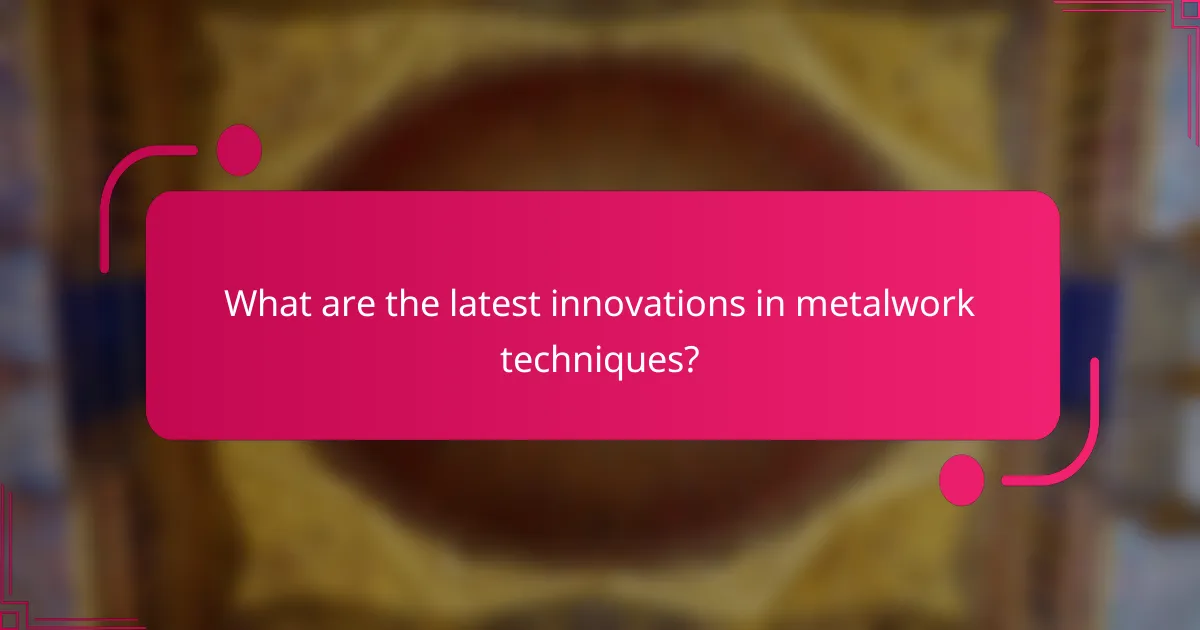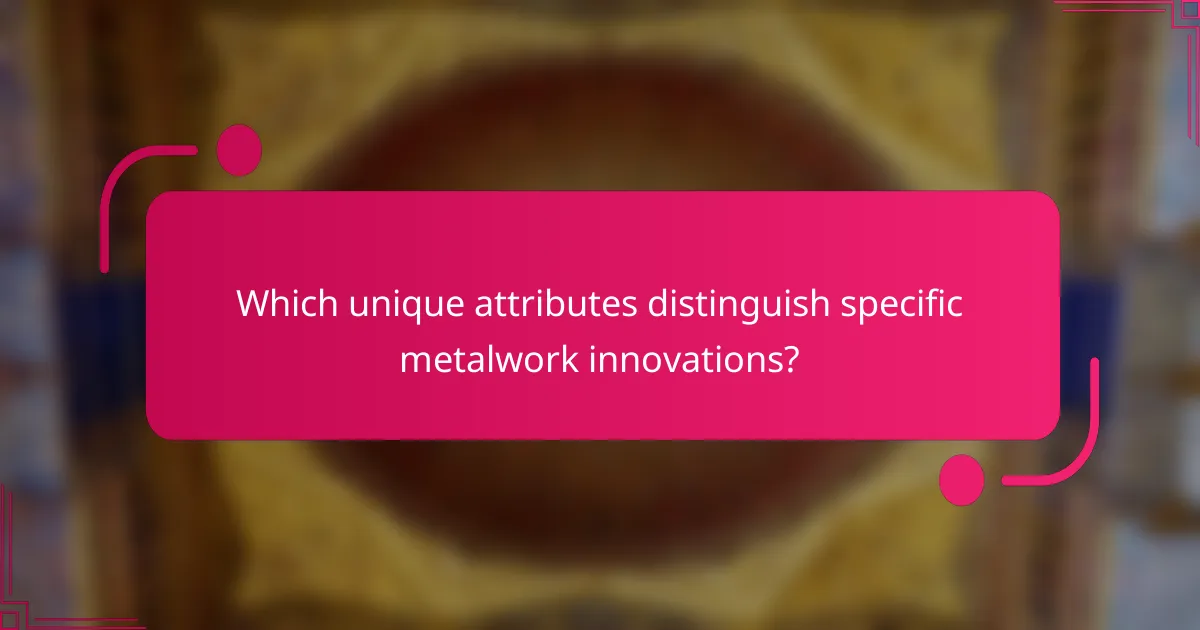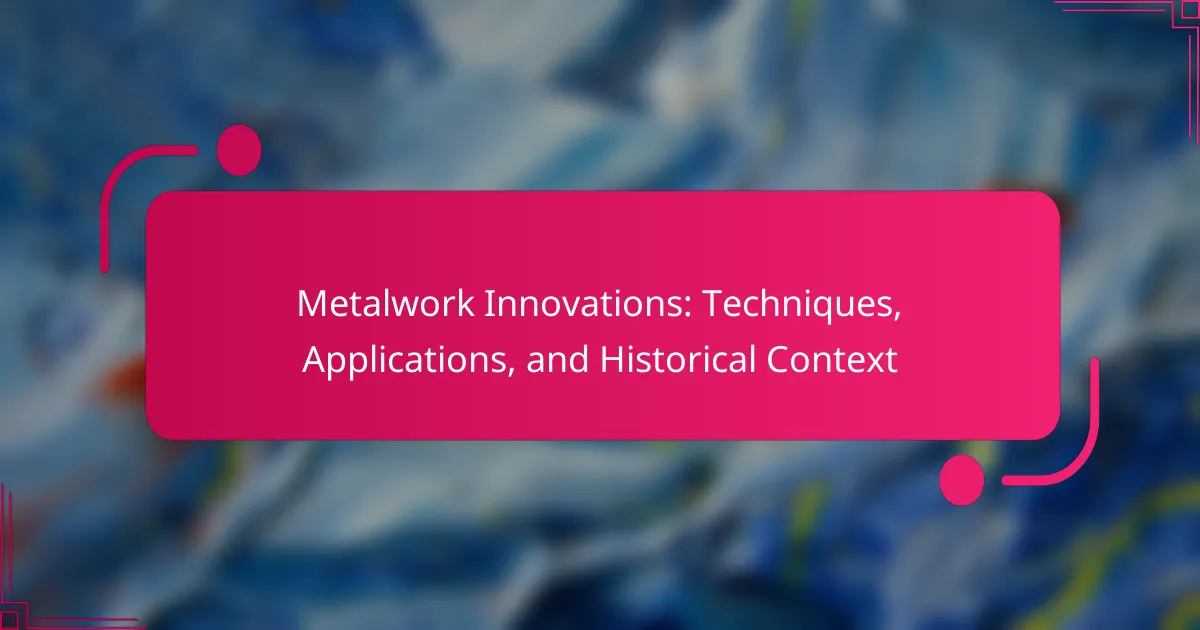Metalwork innovations are transforming industries by enhancing efficiency and sustainability. This article explores advanced techniques like additive manufacturing and smart alloys, their applications in sectors such as aerospace and healthcare, and the historical context that shaped modern practices. Additionally, it addresses the challenges faced in adopting these innovations and highlights future trends driving the metalworking field forward.

What are the latest innovations in metalwork techniques?
Recent innovations in metalwork techniques include additive manufacturing, advanced welding methods, and smart metal alloys. Additive manufacturing enables complex designs through 3D printing, enhancing customisation. Advanced welding techniques, such as laser and electron beam welding, improve precision and reduce material waste. Smart metal alloys adapt to environmental conditions, offering unique properties like shape memory. These advancements reflect the industry’s shift towards efficiency and sustainability.
How do additive manufacturing methods enhance metalwork?
Additive manufacturing methods significantly enhance metalwork by enabling complex geometries, reducing material waste, and accelerating production times. These techniques, such as selective laser melting and electron beam melting, allow for the creation of intricate designs that traditional methods cannot achieve, offering unique attributes like lightweight structures without compromising strength. Additionally, the ability to produce parts on demand minimises inventory costs and leads to more sustainable practices in metalworking. As a result, industries can innovate rapidly while maintaining high-quality standards.
What role does CNC machining play in modern metal fabrication?
CNC machining is vital in modern metal fabrication, enhancing precision and efficiency. It automates processes, allowing for complex designs and consistent quality. This technology reduces material waste and shortens production times, making it essential for industries like aerospace and automotive. CNC machines can execute intricate cuts and shapes that manual machining cannot achieve, showcasing their unique capability in producing high-tolerance components. As a result, CNC machining plays a crucial role in advancing metalwork innovations.

Which applications of metalwork are transforming industries today?
Metalwork innovations are revolutionising industries through advanced techniques such as additive manufacturing and precision machining. These applications enhance efficiency, reduce waste, and enable customisation. For instance, 3D printing allows for complex designs that traditional methods cannot achieve, transforming sectors like aerospace and healthcare. Additionally, smart metalworking integrates IoT technology, optimising production processes and improving product quality. These advancements highlight the unique ability of modern metalwork to meet evolving industrial demands.
How is metalwork being utilised in the automotive sector?
Metalwork is crucial in the automotive sector for enhancing vehicle performance and safety. Innovations in metalworking techniques, such as advanced welding and machining, improve structural integrity and reduce weight. For instance, aluminium and high-strength steel are increasingly used to create lighter, more fuel-efficient vehicles. Additionally, metalwork applications in manufacturing components like engine parts, chassis, and body panels ensure precision and durability. Historical advancements in metalwork have paved the way for modern automotive technology, significantly impacting design and production efficiency.
What are the advancements in metalwork for aerospace applications?
Recent advancements in metalwork for aerospace applications include additive manufacturing, lightweight alloys, and advanced welding techniques. These innovations enhance performance, reduce weight, and improve fuel efficiency. For example, titanium alloys offer high strength-to-weight ratios, while 3D printing allows for complex geometries that traditional methods cannot achieve. As a result, these advancements contribute significantly to the overall efficiency and effectiveness of aerospace engineering.

How has historical context shaped contemporary metalwork practices?
Historical context has significantly influenced contemporary metalwork practices through the evolution of techniques and cultural applications. Innovations such as welding and casting have roots in ancient civilisations, shaping modern craftsmanship. For instance, the use of bronze in ancient tools laid the groundwork for contemporary metal alloys, enhancing durability and versatility. Additionally, historical trade routes facilitated the exchange of techniques, leading to diverse applications across cultures. Contemporary metalworkers often draw inspiration from historical designs, integrating traditional aesthetics with modern functionality, thus bridging the past and present in their creations.
What traditional metalworking techniques still influence modern methods?
Traditional metalworking techniques, such as forging, casting, and welding, significantly influence modern methods. These techniques provide foundational skills and principles that enhance contemporary craftsmanship and innovation.
Forging, an ancient method, involves shaping metal through hammering or pressing, which improves strength and durability. Modern blacksmithing still employs these principles in creating tools and art pieces.
Casting, where liquid metal is poured into moulds, continues to be vital in producing complex shapes. Techniques like sand casting and investment casting are prevalent in industries ranging from automotive to aerospace.
Welding, which joins metal pieces through heat, remains essential in construction and manufacturing. Modern welding techniques, such as MIG and TIG, build on traditional practices, ensuring structural integrity and precision in assembly.
Overall, these traditional techniques not only preserve craftsmanship but also inspire ongoing innovation in metalworking.
How did the Industrial Revolution impact metalwork innovations?
The Industrial Revolution significantly advanced metalwork innovations through mechanisation and new techniques. Innovations like the steam engine and power hammer increased production speed and precision. Factories replaced manual labour, enabling mass production of metal tools and components. This transformation led to the development of specialised alloys and improved casting methods, enhancing metal durability and functionality. As a result, industries such as construction and manufacturing experienced unprecedented growth and efficiency.

What are the core benefits of advanced metalwork techniques?
Advanced metalwork techniques offer enhanced precision, improved material properties, and greater design flexibility. These benefits lead to stronger, lighter components, reducing waste and production costs. Innovations like additive manufacturing and laser cutting exemplify these advancements, allowing for intricate designs that were previously unattainable. As a result, industries such as aerospace and automotive significantly improve efficiency and performance through these techniques.
How do these techniques improve efficiency and precision?
Metalwork innovations enhance efficiency and precision through advanced techniques like CNC machining and laser cutting. These methods reduce material waste, increase production speed, and improve dimensional accuracy. For instance, CNC machines can operate continuously, leading to higher output rates. Additionally, laser cutting allows for intricate designs with minimal heat distortion, ensuring superior quality. Overall, these innovations streamline metalworking processes, making them more effective and precise.
What environmental considerations are addressed by new metalworking methods?
New metalworking methods prioritise environmental sustainability by reducing waste, energy consumption, and emissions. Techniques such as additive manufacturing minimise material usage and allow for recycling. Advanced machining methods improve efficiency, lowering energy requirements. Sustainable materials, like biodegradable composites, are increasingly used, enhancing the eco-friendliness of metalworking processes.

Which unique attributes distinguish specific metalwork innovations?
Unique attributes distinguishing specific metalwork innovations include their material composition, fabrication techniques, and applications in various industries. For example, the use of titanium in aerospace engineering offers a unique combination of strength and lightweight properties. Additionally, advancements in 3D printing technology allow for intricate designs that were previously impossible with traditional methods. The historical context also reveals how innovations like Damascus steel were prized for their unique patterns and durability, setting them apart in historical weaponry.
How does the use of smart materials redefine metalwork?
The use of smart materials significantly enhances metalwork by introducing adaptive properties that respond to environmental changes. These materials allow for increased flexibility, strength, and functionality in metal applications. For instance, shape-memory alloys can return to a predetermined shape when heated, revolutionising design possibilities. Additionally, self-healing materials can repair damage autonomously, extending the lifespan of metal structures. As a result, smart materials not only improve performance but also reduce maintenance costs and increase sustainability in metalwork.
What are the implications of nanotechnology in metal fabrication?
Nanotechnology significantly enhances metal fabrication by improving material properties and production processes. It enables the creation of lighter, stronger metals with superior corrosion resistance and thermal stability. This technology facilitates precise control over material structure at the nanoscale, leading to innovations such as nanocomposites and coatings. As a result, industries benefit from increased efficiency, reduced waste, and enhanced performance in applications like aerospace and automotive manufacturing.

What challenges do metalworkers face with innovation adoption?
Metalworkers face several challenges in adopting innovations. Key issues include high costs, resistance to change, and the need for specialised training.
Financial constraints often limit investment in new technologies. Many metalworkers prioritise immediate production needs over long-term innovation benefits.
Additionally, established practices create a culture resistant to change. Workers may fear that new methods could disrupt workflow or job security.
Training is critical for successful innovation adoption. Metalworkers must learn new techniques and technologies, which can be time-consuming and costly.
These challenges hinder the integration of advanced techniques, such as additive manufacturing and automation, into traditional metalworking practices.
How do economic factors influence investment in metalwork technologies?
Economic factors significantly influence investment in metalwork technologies by determining resource allocation, innovation rates, and market demand. Factors such as interest rates, economic growth, and industry regulations directly affect funding availability and technological advancements. For instance, during economic downturns, companies may reduce investment in new technologies, opting to maintain existing equipment. Conversely, robust economic growth can spur investment in advanced metalwork techniques, enhancing productivity and competitiveness. Additionally, global market trends and supply chain dynamics impact investment decisions, driving companies to adopt innovative solutions to meet evolving consumer demands.
What skills are essential for metalworkers to adapt to new techniques?
Essential skills for metalworkers include adaptability, technical proficiency, creativity, and problem-solving. These skills enable them to embrace innovations and new techniques effectively.
Adaptability is crucial as metalworking technologies evolve rapidly. Technical proficiency ensures mastery of tools and materials, while creativity fosters unique solutions. Problem-solving skills allow metalworkers to tackle challenges that arise with new methods.
Continuous learning is vital, as it helps metalworkers stay updated with industry advancements. Collaboration and communication skills enhance teamwork, especially in complex projects involving multiple disciplines.
In summary, essential skills for metalworkers encompass adaptability, technical proficiency, creativity, problem-solving, continuous learning, and collaboration.
What are common misconceptions about metalwork innovations?
Many misconceptions exist about metalwork innovations, including the belief that they are solely modern advancements. In reality, many techniques have historical roots, with traditional methods influencing contemporary practices. Another common myth is that metalwork innovations are limited to industrial applications; however, they also play significant roles in art and design. Additionally, some people think that new technologies, like 3D printing, completely replace traditional methods, but they often complement existing techniques rather than replace them. Finally, there is a misconception that metalwork innovations are only about efficiency; they also focus on sustainability and reducing environmental impact.

What future trends are expected in metalwork innovations?
Future trends in metalwork innovations include advancements in 3D printing, smart materials, and sustainable practices. These innovations enhance efficiency and reduce waste. For instance, additive manufacturing allows for complex designs that traditional methods cannot achieve. Smart materials enable self-healing capabilities, improving durability. Sustainable practices focus on recycling and using eco-friendly materials, aligning with global environmental goals. Additionally, automation and robotics are streamlining production processes, increasing precision and reducing labour costs.
How might automation and robotics change the landscape of metalwork?
Automation and robotics will significantly enhance metalwork by increasing efficiency and precision. These technologies reduce human error and streamline production processes. Advanced robotics can perform complex tasks, such as welding and machining, with consistent quality. Additionally, automation allows for real-time monitoring, improving safety and reducing waste. As a result, the future of metalwork will likely see a shift towards smart factories where human workers collaborate with machines. This synergy will drive innovation and open new applications in industries like aerospace and automotive.
What emerging materials are likely to influence future metalworking?
Emerging materials likely to influence future metalworking include advanced alloys, composites, and nanomaterials. These innovations enhance strength, reduce weight, and improve durability. For example, titanium alloys offer superior corrosion resistance, while carbon fibre composites provide exceptional tensile strength. Additionally, 3D printing with metal powders enables complex geometries that traditional methods cannot achieve. The integration of these materials will redefine applications in aerospace, automotive, and construction industries.
What best practices should metalworkers adopt for successful innovation?
Metalworkers should adopt collaborative approaches, continuous learning, and technology integration for successful innovation. Engaging with diverse teams fosters creativity and enhances problem-solving. Regular training on new techniques ensures skill advancement. Embracing advanced technologies like automation and digital fabrication streamlines processes and improves precision.
